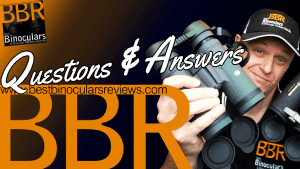

 |
||||||||||||||
 |
||||||||||||||
|
||||||||||||||
Awards: Best Night Vision Device 2012
Later on in the year I am going on a 5 day hiking and camping safari in Zimbabwe where the only gear you can take is what you can carry yourself and so obviously the size and weight of everything is important. Items on my list include essential things like clothes, my tent, torch and sleeping bag (food & drink is taken for us). Then there are the "must haves" and this includes my camera, binoculars and some sort of night vision device: Yes, after the incredible experiences that I had with the excellent Luna Optics LN-PB3 night vision binoculars last year out in the bush, night vision has gone from nice to have to must have.
I would love to take the LN-PB3 binoculars again, but last year, I was not hiking and so size and weight were not such a big issue, this year I need it to be as compact and lightweight as possible. When I mentioned this to the guys at Opticalia Ltd, the UK distributors of Luna Optics, they immediately suggested that I take a look at their new Gen2+, palm-sized mini-monocular, the LN-EM1-MS. Added to that they also suggested that if I had the space, I should also attach the Luna Optics LN-ELIR Laser IR Illuminator to it, which they said would dramatically increase their range.
I have been testing and using them for a few weeks now and below you can read my full review of the Luna Optics LN-EM1-MS Night Vision Monoculars as well as the LN-ELIR Laser IR Illuminator:
Selected Highlights
Before we take a look at the actual monocular, I thought it would be useful to quickly go over the basics of how the night vision on this device works:
Whatever available light there is (ambient light from stars, the moon and man made lights etc) reflects from the viewed object and then passes through the objective lens of the LN-EM1-MS night vision monoculars. This then creates an image of that object on a photo cathode screen, which is located on the front of an Electronic Intensifier Tube inside the device.
Inside this Electronic Intensifier Tube, the light is electronically amplified and projected in a green glow on a phosphorescent screen, located on the back of the tube. This illuminated image is then picked up by the Ocular and transmitted to your eyes.
In situations of complete darkness or if there is not enough ambient light, you can use the built-in Infrared illuminator that emits Infrared light onto the object that you want to view, this then reflects back and is amplified by the tube the same way as ambient light. For more information, take a look at my section on night vision devices.
Design
Like many night vision devices and especially those from Luna Optics, these have an aggressive, rather masculine look to them and just like the LN-PB3 night vision binoculars, they really do look like they mean business.
But unlike many other optical devices that I review, especially most standard daytime monoculars and binoculars that have a rubber armouring, Luna Optics have left the aluminium body of the LN-EM1-MS exposed. This does add to the tough, masculine look of the monocular and I guess in a very small way helps to keep the weight of the device down, but the lack of this coating does have a few drawbacks:
A rubber armour would help protect the night vision monocular from small knocks and bumps and without it, there is more chance of them making a louder sound if something like your watch or more commonly a ring on your finger strikes against them. Rubber armour helps dampen down the sound and thus makes sure that you don't give your position away (important for security surveillance) or frighten away easily spooked animals like birds or deer. Rubber armouring can also help with grip, but because there are grooves and indents all over the body of the LN-EM1-MS, I doubt if it would make much of a difference with grip on these.
Rubber is also much less reflective than metal, but having said that, it is good to see that Luna Optics have finished the body of this monocular in a dull black color to make them as unreflective as possible and thus helping you to remain hidden and undetected should you need to.
The objective lens is set really deeply within the end of the main barrel (about 16mm), this is an aspect of the design that I really like because this will help protect the lens when the cap is removed.
On the right hand side of the main barrel, there are two smaller tubes (show in the image above). The top one has the on/off switch on the end of it and is also used to turn on and adjust the power levels of the built in IR illuminator.
The second tube has a sprung screw top opening at the back and it where you insert the single AA type battery, which is all that is needed to power the device. Rather incredibly this commonly available battery size will according to Luna Optics, power the LN-EM1-MS for 25 hours without the IR illuminator switched on. I can't confirm this, but I have been using it with and without the IR for quite a few nights now and have so far not needed to change the battery. The cap to this battery compartment is tethered to the body is excellent as you don't want to misplace or drop it in complete darkness and which shows some really good attention to detail.
Built-in 2-power level IR illuminator
At the front of the lower tube, you can see the small bulb for the built in Infrared (IR) illuminator, this allows you to see in complete darkness - so when there is no ambient light from sources like the stars, moon or street lights etc.
Unlike the LN-ELIR Laser IR Illuminator that can be bought as an accessory, the built in one is a LED (light emitting diode) infrared illuminator, which is designed to be used at much closer ranges. Despite the very small size, the light generated by a modern diode like this one is characterised by high light power and low power consumption. Another advantage of this type of illuminator is the extreme long durability of the diode.
It works by emitting Infrared light, that is invisible for the human eye, but which reflects from the viewed object back to the monocular and is then amplified by the tube inside it in the same way as ambient light. So in effect you are making your own light to see with and so the IR illuminator should be used in complete darkness, or whenever there is not enough ambient light to see clearly.
The built-in Infrared illuminator has two power levels (high and low illumination modes) which can be adjusted on the main on/off switch.
To turn it on, you fist turn on the main unit by rotating the Power & IR Switch (see image above) to the ON position and then to turn on the illuminator, you have to slide forward the top plate on the switch and rotate it at the same time to the IR position. This sliding lock makes turning it on a little tricky, but is there to prevent it from accidentally been switched on and so preserves your battery life. When you look thought the eyecup on the monocular, you will see a little red indicator, which is there to remind you that it is on. You can then rotate the switch even further to the IR+ position which increases the brightness of the IR illuminator.
When it is on and you are looking at a nearby object, you will now see a bright beam of light within the center of your field of view. It is important to remember that this built in IR illuminator is designed to be used at very short distances and when there is very little or no ambient light, as you increase the distance of objects you are looking at, you will notice that the intensity of the IR light fades away.
Chassis Construction
As mentioned earlier, the main chassis on the Luna Optics LN-EM1-MS Night Vision Monocular is made from aluminium, which is both lightweight and strong and although I never tested them to destruction (they have to go back... unfortunately!), holding them, they do indeed feel nice and solid as well as robust giving you that lovely "feeling of quality".
Waterproofing
Whilst this device is not fully waterproof, it does have some weather resistant protection. So basically I would say that this means you can use it in light rain and moisture, but don't drop it into the water or use in very wet conditions (If you require a fully waterproof and fogproof night vision monocular, take a look at the Luna Optics LN-EMG1-PRO model).
The Eye Cup
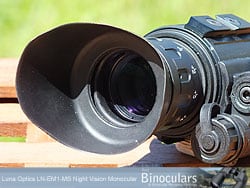 I love the eye-cup that comes with this night vision monocular. Made from a really soft rubber, I guess it would be better described as an eye-shield as it has a flap that is designed to fit against the side of your face to cut out any light entering from the sides.
I love the eye-cup that comes with this night vision monocular. Made from a really soft rubber, I guess it would be better described as an eye-shield as it has a flap that is designed to fit against the side of your face to cut out any light entering from the sides.
The eyecup can be rotated independently of the ocular focussing ring so that you can get the flap positioned correctly depending on weather you use the monocular with your left or right eye.
It has an external diameter of 40mm and has also has been designed so that there is a spring like mechanism at the base of the eyecup to enhance comfort which works pretty well as even when pressed quite firmly to my face, I found them to be comfortable.
Focusing
Setting up the Luna Optics LN-EM1-MS Night Vision Monocular for your eyesight and then focussing it on objects depending on their distance away from you is actually very similar to how you would do it on a standard pair of binoculars.
First you rotate the Ocular Focusing Ring (see image above) in either direction, until you get the best possible focus on an image. The you rotate the Objective Lens (see image above) to the point at which the image is at it's best. If the image is still not completely sharp and clear, you just repeat this process until it is. Then once you have a clear and sharp image, you no longer need to rotate the Ocular Focusing Ring, you just rotate the Objective Lens to focus on objects at different distances from you.
So essentially the focussing wheel is the objective lens itself and like the rest of the body, the exterior is made from hardened aluminium with large indents cut into it to help with grip. It has an exterior diameter of 32mm which is just about the same as the focusing wheels most standard full sized roof prism binoculars (The actual diameter of the objective lens is 26mm).
On the device that I was testing, it turned really smoothly had a good amount of resistance so that it would not turn accidentally, yet not so tight that it made focussing difficult. I found that the easiest way for me to focus was to use the opposite hand to which I was holding the monocular with, but I imagine some people with larger hands could actually adjust it with the same hand that the are holding the device with.
Because it protrudes out from the front of the night vision monocular, and is fairly large and because is nicely grooved it makes adjusting the focus even with thick gloves on, no problem at all - this is an important consideration when conducting surveillance operations in cold conditions.
It takes just one full turn of the objective lens to go from infinity to it's minimum focusing distance of just 0.8ft. (25cm). What this means is that focusing from near to far (or vise versa) is pretty quick and takes less time than those with lower geared mechanisms and has the advantage of making fine tuning your focus to get it exactly right much easier than more aggressively geared mechanisms.
Ocular Focusing Ring
The Ocular Focusing Ring (see image above) is located between the eyecup and the main barrel of the monocular and is made from metal with grooves cut into it to help with grip.
This ring is used to correctly set up and focus the monoculars to your particular eyesight and only really only needs to be done once when you first use the device (or if you share it with others). I like the fact that there are a number of markings on the ring, meaning that you can use them as a reference point to easily return to, should you want to change it for any reason (like when sharing your monoculars). It would have been even better if it was lockable which would prevent it from being accidentally moved, but even so it is not hard to re-adjust it should it be moved.
Best Binoculars Rating for Body Construction Quality: 7/10
Weight
Not only can the Luna Optics LN-EM1-MS easily fit into the palm of your hand, but its all aluminum body and the fact that it only uses 1xAA battery, means that it weighs only 340g (12 oz) and even if you add the LN-ELIR IR illuminator, it only adds 100g (3.5oz) to the total weight of the device. This makes it the lightest night vision device from Luna Optics and one of the lightest available on the market.
To put their weight into context, take a look at a few other night vision devices that I have reviewed as well as a few other similar ones on the market:
As with standard day-time binoculars and monoculars, if you just look at the weight alone, it can sometimes be misleading. This is because some of the lightest devices are also amongst the cheapest (and worst) as they use sub-standard materials in their construction that may be lighter, but is definitely not as tough or durable. So whilst the LN-EM1-MS is very light, it is not because they use cheap plastic materials, in fact the opposite is true as the main chassis is made from hardened aluminium.
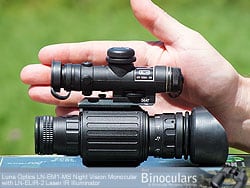 Dimensions
Dimensions
Described in their marketing as a palm-sized mini-monocular, the LN-EM1-MS has an advertised length of 12.9cm (5.1in) - this is the length of the main body and does not take into account the rubber eyecup that can be folded back. If you include this, it's length increases to 16cm (6.3in).
At their widest point, they measure 6.8cm (2.7in) and their height is 5.5cm (2.2in) which are both their advertised dimensions. If you add the LN-ELIR IR illuminator to the device, it increases their height to 10.3cm (4.1in).
So as you can see, describing them as palm-sized, maybe stretching the truth a little (with my sized hands anyway), but they really are very really compact making them really portable and therefor ideal for a wide variety of applications where weight and size are a factor. This lightweight and compact design also makes them an ideal choice if you want to attach your night vision monocular to a head-mask, for hands free use.
BBR Rating for Body Stats: 9/10
26mm Objective Lens
In general, the larger the objective lens, the more light gathering potential of your optics. Therefore giant objective lenses may seem ideal especially when the amount of available light is so minimal as is the case at night, but large diameter lenses increase the size, weight and cost of the device and so you have to find the right balance. But wait, there is more...
Transmittance
As well as light gathering, you also need to get as much of this light as possible to the photo cathode screen located on the front of the Electronic Intensifier Tube inside the monocular. This is called transmittance and the higher the transmittance (more light) the better quality and brighter an image the Electronic Intensifier Tube can produce. So it is also vitally important that the objective lens on a night vision monocular has a very high level of light transmittance in the visible as well as the near Infrared light.
Some of the factors that effect the level of transmittance of the objective lens include:
Lens Coatings
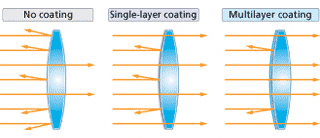 To reduce the amount of light that is reflected away from the surface of the lens, anti-reflective coatings are used. These can make a really big difference to the amount of light transmitted and therefore a big difference to the brightness of the image produced.
To reduce the amount of light that is reflected away from the surface of the lens, anti-reflective coatings are used. These can make a really big difference to the amount of light transmitted and therefore a big difference to the brightness of the image produced.
Luna Optics say that they use "all-glass multicoated optics" on the LN-EM1-MS. This means that at least some air to glass surfaces (usually the first and the last) have multiple layers of antireflection coatings that help to increase the light transmission, thus producing a better quality and brighter image.
I presume that the reason that they highlight the fact that these use "all-glass optics", they are saying that there are some devices on the market that use other materials other than glass, but I am not sure?
1x Magnification
The fact that this night vision monocular does not magnify the image has a few advantages as well as a few disadvantages.
On the negative side, the obvious issue is that because it does not magnify the image, it does not bring distant objects "closer" to you for a better view. If this is an issue for you, you can actually get around this with these LN-EM1-MS night vision monoculars by adding a 4x or even 7x High Magnification Lens which can be purchased as an accessory from Luna Optics.
On the plus side there are a number of advantages to not magnifying the image:
To explain how optical devices with higher magnifications transmit less light, you can take the amount of possible transmittance, which can be expressed as a number, known as the F-number and is calculated by dividing the focal length by the diameter of the entrance pupil (effective aperture which in the case of a monocular like these is the diameter of the objective lens). So ignoring differences in lens transmission efficiency, the greater the F-number (the less light is transmitted through the objective lens), the fainter the images created (measuring brightness per unit area of the image).
This LN-EM1-MS night vision monocular has an advertised F-stop of 1.1 and 26mm diameter objective lenses (entrance pupil diameter), which means we can work out their focal length(f): f/26=1.1 therefore f (focal length) = 28.6mm
If you wanted to increase the magnification of the device, remembering that in all telescopy, where the subject is essentially infinitely far away, a longer focal length (lower optical power) leads to higher magnification (as well as a narrower angle of view).
Now lets assume that you now have a greater magnification and you now have a longer focal length of say 52mm and the entrance pupil diameter (objective lens) stays the same at 26mm, the F-number is now 2 and therefore less light would be transmitted through the objective lens than the first example that had a lower magnification (shorter focal length).
So this transmittance level and the f-number are why the magnification of the night vision devices is generally much lower than used in daylight optics (monoculars, binoculars or spotting scopes). It is important to consider the fact that when employing higher magnification, the objective lens elements are thicker and therefore transmit less light than thinner lens. As every little bit of light transmitted is so important during the night the magnification of most night vision devices ranges from 1x to 7x, thus preserving the best possible balance between image magnification and the light transmission.
Ocular (Eyepiece)
The Ocular is as important as the objective lens for any night vision device, as it picks up the illuminated image from the Intensifier tube and brings it to your eye.
The ocular lens is pretty large and has a diameter of 25mm and Luna Optics state that all of their units come with high quality all-glass oculars with anywhere between 4 and 21 lens elements to provide the highest possible image quality to the user. Unfortunately I have not as yet been able to find out any more details on specifically what is used on the LN-EM1-MS.
Best Binoculars Rating for Optical Components Quality: 7/10
Field Of View
Because the device does not magnify the image, you get an incredibly wide field of view (FOV) of 40° which equates to 2517 feet@1000 yards or 839m @ 1000m. This very wide FOV gives you a really good overall picture of what is going on around you when you are using the monoculars. To put this in context and to see how magnification affects the FOV take a look at a few other optical devices below:
Close Focusing Distance
The minimum close focusing distance a very close 25cm (0.8ft), which combined with the 1x magnification and the head-mask, makes them ideal as a night vision device for walking at night or if you need to work in the dark.
Max Viewing Distance:
Their typical maximum viewing distance, without any extra illuminators is 150m (492ft) which is calculated under clear skies when there is a full moon.
I thought it would be interesting as well as informative to compare the stats of this LN-EM1-MS with some other night vision devices including the Luna LN-SM50 and LN-SX3 and night vision monoculars, the Luna LN-PB3 binoculars and another popular and similar device, the ATN NVM14-2 Night Vision Monocular:
| Luna Optics LN-EM1-MS | Luna Optics LN-SM50 | Luna Optics LN-SX3 | Luna Optics LN-PB3 | ATN NVM14-2 | |
| Price (approx): | $1600 (�1900) | $270 (�285) | $200 (�200) | $599 (£650) | $2100 (�1500) |
| Device Type: | Monoculars | Monoculars | Monoculars | Binoculars | Monoculars |
| Generation: | 2+ | 1 | 1 | 1 | 2+ |
| Max Light Amplification | 22,000x | 500 - 700x | 250 - 500x | 900 - 1000x | Not Advertised |
| Sensitivity (microamperes per lumen) | 310-340 | 240 | 240 | 280-300 | Not Advertised |
| Max Image Resolution: | 40 lp/mm | 26-28 lp/mm | 24 lp/mm | 32-38 lp/mm | 40-45 lp/mm |
| Magnification: | 1x | 5x | 3x | 3x | 1x |
| Objective Lens: | 26mm | 80mm | 50mm | 50mm | 27mm |
| F-Number | F1.1 | F1.7 | F1.2 | F1.2 | F1.2 |
| Weight: | 12oz (340g) | 23.6oz (670g) | 15.9oz (450g) | 26.8oz (760g) | 12oz (340g) |
| Length: | 5.1in (12.9cm) | 7.1in (18.2cm) | 6.8in (17.5cm) | 6.5in (16.5cm) | 4.7in (12.0cm) |
| Width: | 2.7in (6.8cm) | 2.1in (5.5cm) | 2.2in (5.8cm) | 4.5in (11.5cm) | 2.7in (6.9cm) |
| Height | 2.2in (5.5cm) | 2.5in (6.5cm) | 2.9in (7.5cm) | 2.2in (5.6cm) | 1.9in (4.9cm) |
| Max Viewing Distance: | 150m (492ft) | 300m (978ft) | 200m (650ft) | 300m (978ft) | Not Advertised |
| Close Focusing Distance: | 0.8ft | 6.6ft | 9.8ft | 6.5ft | 0.8ft |
| Field of View @1000yds: | 2517ft | 475ft | 638ft | 1092ft | 2517ft |
| Field of View (degrees) | 40° | 9° | 12° | 20° | 40° |
Best Binoculars Rating for Optical Stats: 9/10
The Luna Optics LN-EM1-MS uses top grade Generation 2+ night vision technology, which until fairly recently were only being used by Military, but now have become more widely available. Even so, export outside of the US of any Generation-II and II+ model is controlled by the US Department of Commerce and must be approved by submitting an End-User Certificate. (more information on Night Vision Generations)
The Gen 2+ intensifier tubes in this monocular amplify the ambient light up to about 22000 times, which makes a huge difference when you compare them to Gen 1 and G1+ devices that have a max gain of around 900 - 1000x.
All Gen-2+ tubes are Russian-made, as the US technology switched from Gen-2 to Gen-3, bypassing the Gen-2+. The LN-EM1-MS has a max luminous sensitivity of between 310 and 340 microamperes per lumen and due to the Russian legislature, the maximum sensitivity allowed for export outside of Russia is 350 microamperes per lumen anyway.
Maximum resolution at the center of the LN-EM1-MS is between 38 and 40 line-pairs per millimeter, which is about standard for a Gen 2+ device as is the lifetime of 5,000 hours.
Like almost all Generation 2+ devices, this Luna Optics night vision monocular comes equipped with automatic gain control, which regulates the brightness of the image depending on the outside light condition. The LN-EM1-MS also has a flash protection which protects the device in the case of accidental , or sudden exposure to bright light.
Luna Optics are also proud of the fact that they only buy the top grades of the intensifier tubes and you can be sure that you are getting the best quality possible. Additionally, as a part of their quality control, every Luna Optics device is inspected twice: once at the factory level and once again at their US warehouse prior to shipment.
Brightness & Image Quality
So what does all this technology all mean in real terms? Below are my thoughts and opinions after using them at different times and on a number of different nights with varying amounts of ambient light.
I currently live on a rural farm in the south of France, which means that apart from the moon and the stars, once all the lights have been switched off in the house, there really is not that much (if any) ambient light from other sources.
I used the LN-EM1-MS for the first time on a cloudless night and with a crescent moon, so a clear, but not the brightest of nights. Even so, I have to say that the brightness of the image that I first saw was impressive and I could easily make out small individual plants in a hedge row about 50 - 60 meters away. Looking further away and up to about 100m, I could still easily make out many object details and easily pick out trees and bushes at the very edge of my garden and indeed even ones much further away in the farmlands behind my house. Very impressive.
Overall and with out using any illuminator, I would say the image is quite a bit brighter and definitely has far less dark spots in it (tube blemishes) when compared to the Gen 1 and Gen 1+ devices that I have used in the past. Another feature of most Gen 2+ devices is the virtually distortion free image even right at the edges, which was immediately evident looking through this Luna Optics monocular and which you can clearly notice on the images I took below.
Built in IR Illuminator
I then took the night vision monoculars indoors and chose rooms where there was almost no ambient light, the image produced was obviously much darker and black spots on the screen were far more noticeable, that is until you turn on the built in IR illuminator. The difference it makes is incredible, it immediately lit up the whole image, almost as if someone had switched on the lights. Of course this is exactly what it designed for and in my experience the built in IR had an effective range of about 15 meters (outdoors), after that the difference it makes to the brightness of the image becomes less and less noticeable as you get further away from the object that you are looking at. I imagine that indoors or when there is absolutely no light, this distance may be even greater.
Luna Optics LN-ELIR Laser IR Illuminator
Because I had used the LN-ELIR-1 long range laser IR illuminator before when I reviewed the Luna Optics LN-PB3 night vision binoculars, I was sort of prepared and kind of knew what to expect. But even so when I first turned on the LN-ELIR-2, the bright beam that it produces in the center of your view is absolutely incredible. Whilst the built in IR illuminator is impressive and really helps lighten up the whole field of view when it is very dark almost as if someone has switched on the lights, when you turn on the LN-ELIR-2, it looks like someone is shinning a very bright beam like a spotlight in the center of your view.
This beam of light can be adjusted using the focussing ring at the front of the illuminator and you can widen or narrow the beam of light. Narrowing it helps to increase the viewing distance, whilst by widening it, you illuminate much more of the field of view for a better and brighter overall image. The intensity of the beam can also be adjusted by twisting the on/off adjustment wheel. At full intensity and with a narrow beam of light the effective range of it is incredible. Luna Optics say that it has a viewing range of up to 1,000 meters when used with a Generation-2+ device - I don't think with this 1x monocular if it would be that effective a 1,000 meters (possibly with the 4x or 7x High Magnification Lens attached this would be possible), but even so I could easily make out details of objects at distances of about 300 - 400 meters, which when you take time to remind yourself that it is dark outside is very impressive.
To give you an idea of the high quality image and what to expect, I took the following photos through the eyepiece of the LN-EM1-MS monocular, by just holding up my small compact camera and I sure you will agree they the quality and brightness is pretty impressive:
Best Binoculars Rating for Image Quality: 9/10
Carry Case
The soft carry case is lightly padded and the monocular fits very easily, inside it. The case has a looped wrist strap for carrying and access to the inside is via a long zip that goes round one whole side of the case. On the inside there is also a small pocket that is ideal for storing a few small personal items. Overall the case looks to be pretty well made, but it is possibly not quite as luxurious as some out there.
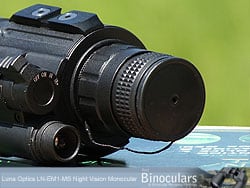 Lens Cover
Lens Cover
The objective lens cap looks to be made from a hard rubber/soft plastic. It fits very well into the end of the barrel and so should not accidentally fall off. I like the fact that it is tethered to the monocular, which allows you to remove it and let it hang down out of the way, without having to put it away somewhere safe. This shows some good attention to detail.
They have small pin hole in them so you can look through the monoculars during the day and I also really like the fact that the objective lens is set very deeply within the body (about 16mm) - which will help protect it when the lens cap is removed.
Warranty Information
Also included within the box are the details of the 1 year warranty, which basically states that in the event your Luna Optics monocular becomes damaged or defective, Luna Optics will at their discretion repair or replace the device at no charge to you.
Luna Optics external Long Range Illuminators
Using one of the two brackets on the body of the monocular, you can attach an extra long range LED or laser infra red illuminator to the device. These are much more powerful than the built in IR illuminator that is attached to the body and dramatically increase the range of the device as well make the image produced much brighter and clearer. Speaking from experience, I highly recommend that you get one as the difference they make is incredible and well worth the extra expense:
Luna Optics LN-ELIR Super Long Range Laser IR Illuminator
LN-ELIR is compact and lightweight yet it is one of the most powerful laser IR illuminators currently available. It comes in three variations, which are all exactly the same, except for the mounting bracket that is used to fit it on your night vision device:
The Luna Optics LN-ELIR-2 that I used for the review has an adjustment wheel on the top which is used to turn it on and it allows you to to fine-tune the beam's intensity. Having it set to maximum is great, but is not always necessary and by lowering the intensity of the beam it will lengthen battery life. By adjusting the focussing ring at the front of the illuminator, you can widen or narrow the beam of light. Narrowing the beam helps to increase the viewing distance, whilst by widening it, you illuminate much more of the field of view for a better and brighter overall image.
The beam can also be adjusted along the X and Y axis to position it precisely in the center of the view of your night vision device by using the suppled key. Each illuminator also comes with a good quality pouch that has a loop allowing you to attach it to your belt.
This was the model that I tested and I was very impressed, it takes the view through these monoculars to a whole new level. The beam it produces is really powerful, and when you look through the monocular and turn it on, it looks like someone has pointed a powerful spotlight in the direction that you are looking and really brightens the image and thus helps you to resolve details much, much better. According to Luna Optics the LN-ELIR-2 increases the viewing range of up to 1,000 meters when used with a Generation-2+ and higher power devices. I never measured the distance out, but it really helps you to see much further and I would highly recommend that if you do get a night vision monocular that you also really consider adding an extra IR illuminator like this one as it really makes a huge difference at both short and longer ranges.
Luna Optics LN-EIR LED IR illuminators
Also compatible with the LN-EM1-MS is the Screw Adapter version of the LN-EIR LED IR illuminator. The LN-EIR-2 is even more compact and lightweight than the laser version above, but unlike the laser which can extend viewing distances to 1000 meters, the LED (light emitting diode) version is for closer ranges of up to 200m. There are two-level illumination switch provides high and low illumination modes and allows user to customize the viewing field to the most comfortable level.
The beam on this illuminator can also be custom adjusted along the X and Y axes to perfectly position the beam in the center of the screen of your particular night vision device and each illuminator comes with carry pouch that fits to the belt.
High Magnification Lenses
Luna Optics have a couple of High Magnification Lenses that are compatible with the LN-EM1-MS, which will turn them into a high quality, long distance observation system with minimal light loss!
Designed specifically for use with Gen-2+ products., they feature multi-elements, all-glass lenses with multiple levels of our proprietary coating, which aids in faster light transmission, the LN-L100 (4x) and LN-165 (7x) are built from aluminum, the lens barrels are secure, sturdy, resist nature elements and match the exterior of the LN-EM1-MS for a seamless look and feel.
Attaching the lens is a quick and easy process as they actually replace the original 1x objective lens and once attached, the lenses provide full field of view and unmatched image clarity unlike "doubler" or "tripler" systems that attach over the standard 1X lens, which greatly reduces the visible field of view and adversely affecting the image brightness.
Luna Optics LN-HMS Head-Mask
These night vision monoculars can be attached to a head-mask, which frees up both of your hands. The LN-EM1-MS has a brackets on the top and the bottom of the device, which can be used to mount the monocular to the head mounting system. Unfortunately I did not have one to test for the review so can't comment on it too much more than this.
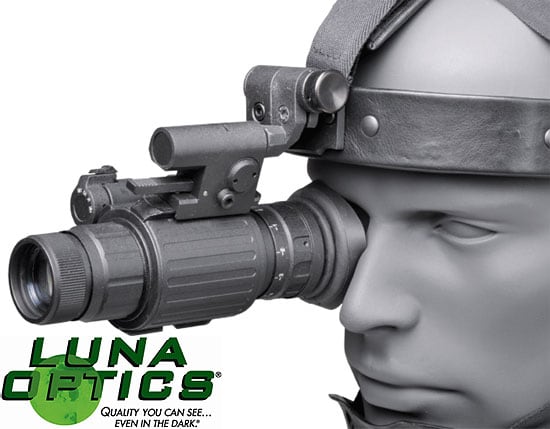
Best Binoculars Rating for Extras & Attention to Detail: 7/10
Strong Points: Their very compact and lightweight design makes them not only really easy to carry about in your hands, but also very easy to pack away in you bag and take wherever you are going. The Gen 2+ tube and low magnification produce an incredibly bright image which is even more incredible when you consider the relatively small 26mm objective lens. I love the fact that it can be head mounted and the Luna Optics LN-ELIR Super Long Range Laser IR Illuminator is incredible and means that you get a much better view of what is going on at further distances. Also being able to replace the 1x objective lens with higher magnification lenses makes this device very versatile as it can be used for long range observation as well as close range uses.
Weak points? The built in illuminator is only really effective at shorter distances, which to be fair, is what Luna Optics advertise and what it is designed for, but I guess it would be nice to not have to purchase the extra long range laser IR illuminator. I also feel it is a shame that they are not completely waterproof as this would make them far more durable and versatile, especially for those who need a night vision device for outdoor operations in all weather conditions.
Ideal Uses: Because these Luna Optics LN-EM1-MS Night Vision Monoculars have a 1x magnification with a very wide field of view and they can be a hand-held or head-mounted they are perfect for walking, driving, shortish-range surveillance, map reading, vehicle maintenance, and uses like administering first aid in both moonlight and starlight.
For long distance observation and surveillance, I would highly recommend adding the Luna Optics LN-ELIR Super Long Range Laser IR Illuminator to the monocular and possibly look at also adding either the 4x or 7x High Magnification Lenses.
Overall I love using the Luna Optics LN-EM1-MS Night Vision Monoculars, their compact size and very bright image means that I will definitely be taking them with me on my hiking and camping safari later on in the year - I now just can't wait to see what wildlife I will be able to observe. Watch this space!
I would like to thank Opticalia Ltd, the UK distributors of Luna Optics, for providing me with the sample to review - you can purchase these monoculars directly from them or buy and compare prices at a number of online retailers here. I would also like to make it clear that this and all the other reviews on Best Binocular Reviews are completely my opinion and are not influenced in any way by manufacturers, distributors or suppliers.
Reviewed by Jason Whitehead for Best Binocular Reviews
|
 Awards:
Awards:Main Specifications & Features:

Below are similar pairs of Night Vision Monoculars that you may also want to have a look at:
A compact and lightweight entry level night vision monocular that can be adapted to connect to your SLR camera
General Price Range: (6/6) Expensive Night Vision Monoculars
Below is a link that will take you to a page with online retailers in both the US and UK that sell Luna Optics 1x26 LN-EM1-MS Night Vision Monoculars this page makes it easy to compare prices and then to buy from your preferred option:
|
Buy & Compare Prices for the Luna Optics 1x26 LN-EM1-MS Night Vision Monoculars |
||
US Shoppers |
Canadian Shoppers |
UK Shoppers |
Deutsch Shoppers |
Aussie Shoppers |
Indian Shoppers |
